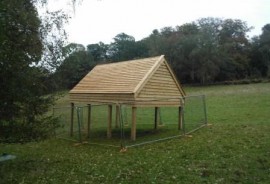The Ecology Consultancy was involved wildlife surveys prior to an extensive redevelopment of the former Brunel University Runnymede Campus in Middlesex, which was the set for the Misfits before work began. The approved scheme provides approximately 43,384m2 accommodation for 528 and ancillary accommodation, 59 extra care units, 28 affordable housing units, 76 private residential units as well as car parking, landscaping and local infrastructure. A range of ecology work was involved, including surveying and mitigating for reptiles, dormice and bats.
The bats on site include common pipistrelles, soprano pipistrelles, serotines, brown long-eared bats and Natterer’s bats, all roosting within buildings, plus a Myotis species recorded in flight using the trees as foraging habitat. Our bat specialists found two pipistrelle maternity colonies, which will be retained in situ and protected during redevelopment works. Summer roosts for the other bat species present were located. Some of these will be retained, whilst suitable replacement roosts will also built into the retained buildings or new construction.
In addition, a hibernaculum is being constructed in a mansion basement as enhancement. This involves leaving an area of the basement closed off and undisturbed, ensuring that conditions are cold and constant. These conditions enable bats to go into torpor over the winter. Suitable roosting crevices will also be provided by fitting wooden wedge boards.
A bespoke bat loft to provide a summer roosting site for a maternity colony of brown long-eared bats was constructed before works began. This was a stand-alone structure made to a certain specifications to be suitable for the species, featuring wooden weatherboarding, shingle roof tiles and plenty of internal, insulated flying space (see bat loft photo). This replacement structure was to replace a roost nearby, which would be lost as a result of the development. Bats use different types of roost at different times of the year (e.g. summer roosts, hibernation roosts) but they are faithful to the roost sites and return to their roosts over the decades. So, to attract the target group to this new, purpose built loft, we seeded this with droppings from the original roost. A small hatch was included so that the structure can be monitored over the next two years to ensure that the bats are using it. Thirty bat boxes were also installed on trees around the site before works commenced.
In order to protect bats whilst the work progressed, demolition plans had to include a bat exclusion process. This involved identifying access points that bats were using and fixing exclusion devices to these, with monitoring surveys carried out at dusk, to check that bats emerge, and at dawn to check that they don’t get back in! This was permitted through the EPSM licence that Natural England had granted, and carried out by a licensed bat ecologist (otherwise these works would be unlawful).
A soft strip of the roof materials then took place. This involved removing the roof and ridge tiles, roofing felt soffit boxes, barge boards and even window shutters (behind which were hundreds of droppings and two common pipistrelle bats!) by hand. Bats frequently roost between construction materials. This photo shows removed hanging tiles and you can see the droppings indicating regular bat use. Further inside the tiny gap pictured, there was a little bat that we observed and excluded! This process made sure that all bats were removed from the building prior to demolition. A licensed bat ecologist moved all bats found, which included a number of common and soprano pipistrelle bats, to replacement roost sites. Work on the site began in 2012 and will be phased through 2013 and 2014 to avoid bat maternity and hibernation seasons (May-August and November-February inclusive).
Our first phase got off to a good start - the contractors assisting us on site had estimated that the timescale and manpower needed for removing roof materials would take 165 man days. However, our pro-active approach on site meant we worked with the contractors and the rapport we developed made for effective teamwork, resulting in significant savings in manpower, plant and equipment hire. Great result!



